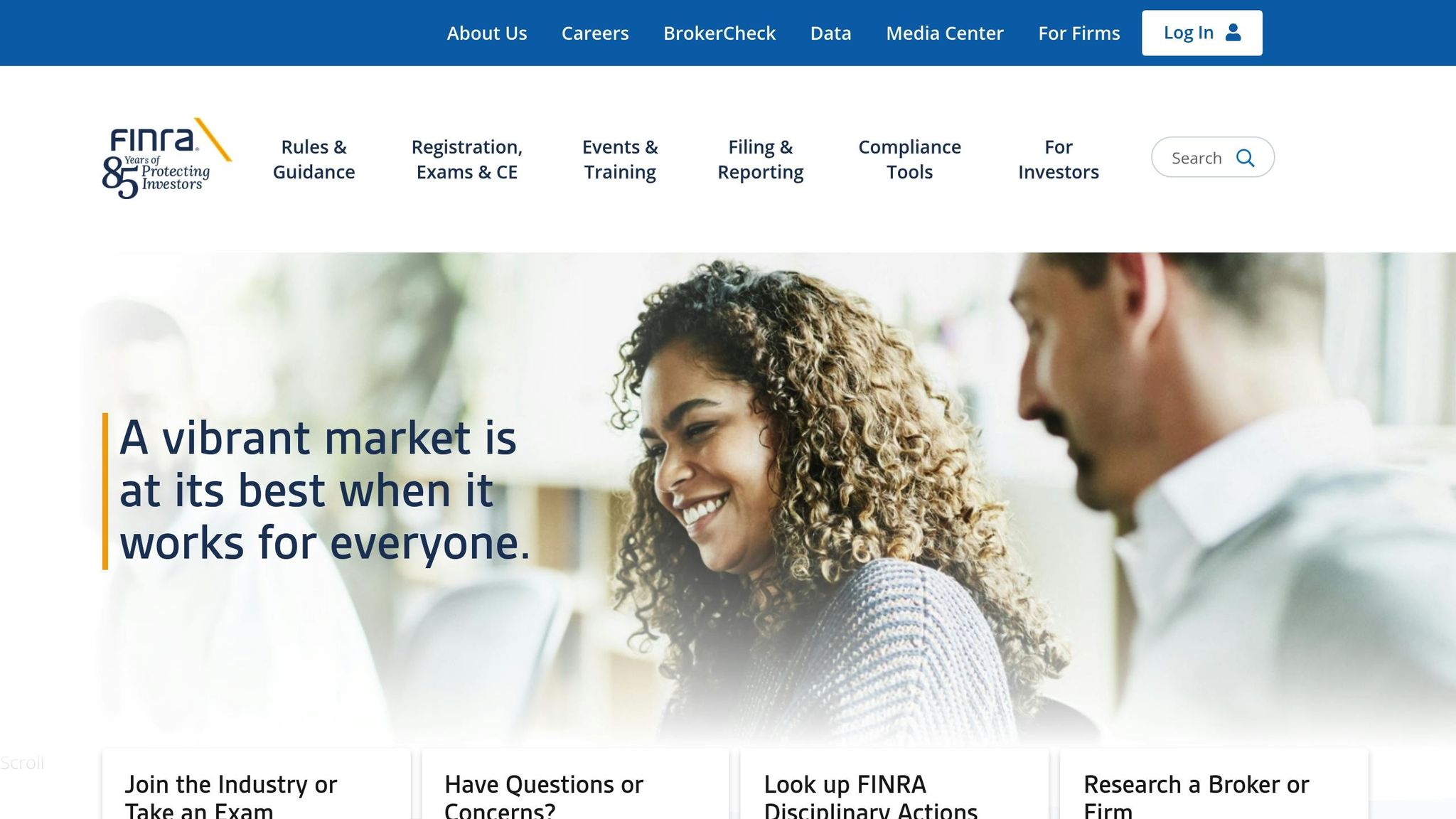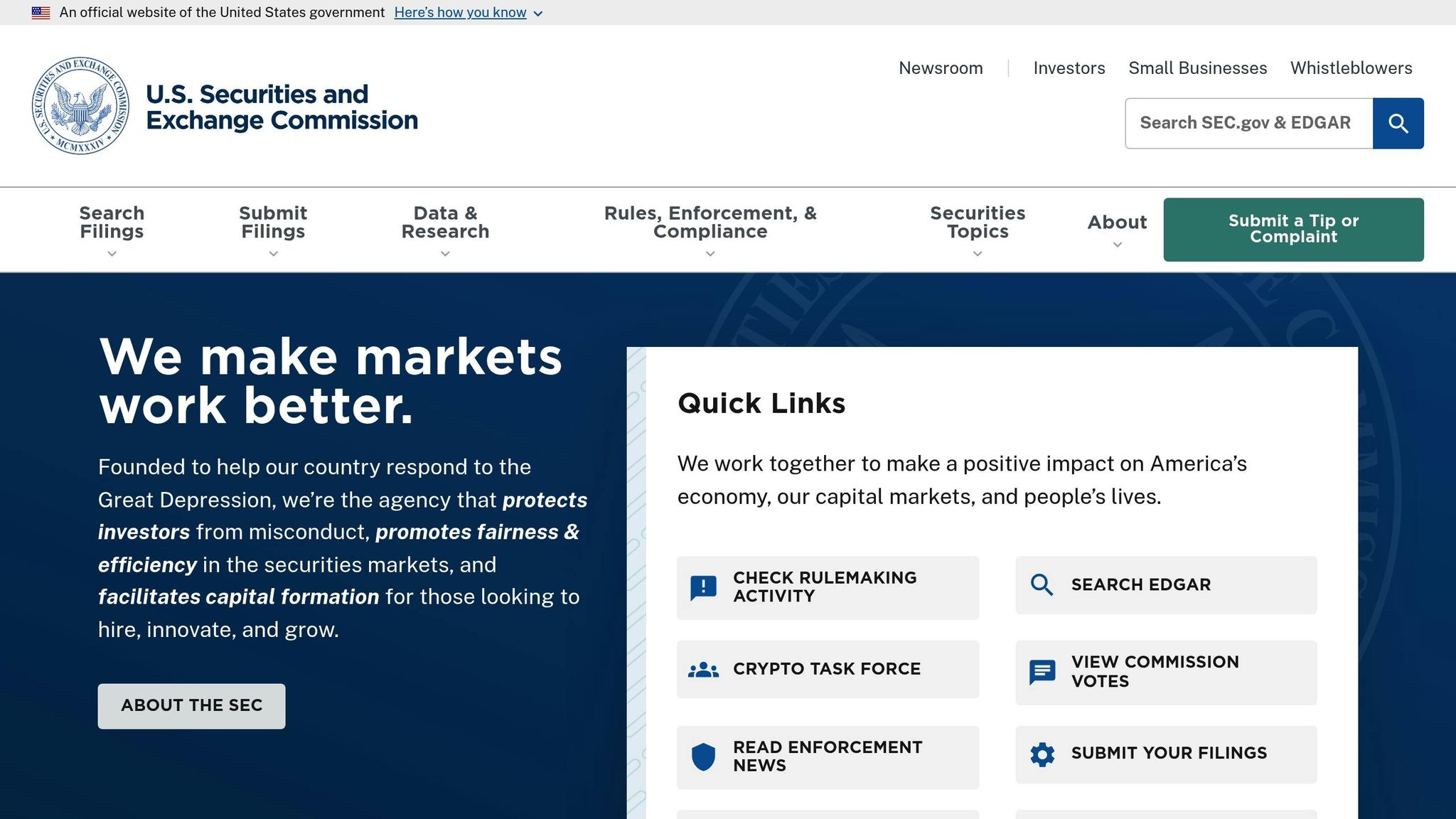
Email compliance in financial services is about following strict regulations to ensure all electronic communications are legal, ethical, and transparent. Violations can lead to hefty fines (up to $53,088 per email), reputational damage, and increased regulatory scrutiny. Here's a quick breakdown of what you need to know:
Compliance isn’t just about avoiding fines; it builds trust and credibility with clients. Financial firms that integrate compliance into their processes can protect themselves while maintaining effective client communication.

FINRA Rule 2210 establishes strict guidelines to ensure fairness, balance, and accuracy in emails, newsletters, and marketing communications. It categorizes communications into three distinct types:
All communications must reflect fair dealing and good faith, presenting information that is balanced and provides a solid basis for evaluating the facts. Firms are mandated to retain all retail and institutional communications for at least three years, documenting vital details like the date, approver, and data sources. Additionally, FINRA may require firms to file retail communications with its Advertising Regulation Department in certain cases.
On top of these requirements, SEC regulations add another layer of disclosure and anti-fraud protections.

The SEC complements FINRA's rules by emphasizing transparency through mandatory disclosures for investment advisers, broker-dealers, and other registered entities. Marketing emails must include clear risk disclaimers and adhere to guidelines around performance data, such as specifying time periods, benchmarks, and associated risks. For investment advisers, any communication that could influence investment decisions must outline the adviser's qualifications, potential conflicts of interest, and any material changes in business operations. These disclosures must be presented in a manner that is clear and accessible to the audience.
Alongside these regulations, the CAN-SPAM Act enforces specific rules for commercial email practices.
The CAN-SPAM Act governs commercial email communications in the United States and applies to all commercial messages, including business-to-business emails. Key requirements include:
Enforcement of these standards is serious. For instance, in May 2025, a fintech startup launched an email campaign targeting CFOs across North America. When the vendor managing the email list failed to disclose consent mechanisms properly, a privacy rights group flagged the campaign as a violation of the CAN-SPAM Act. This led to the company's domain being flagged, emails bouncing, and significant reputational damage. Companies must also ensure that third-party vendors and marketing agencies they work with adhere to these compliance standards.
Effective recordkeeping is a cornerstone of email compliance in financial services, supported by SEC Rule 17a-4 and Investment Advisers Act Rule 204-2(a). Firms are required to retain all incoming and outgoing business communications.
To safeguard these records, firms must implement systems that prevent unauthorized access, tampering, or loss. This includes using encryption and strict access controls. Additionally, firms must establish clear policies for archiving communications, ensuring records are maintained for the required duration, and notify the SEC and their designated examining authority before using electronic storage systems.
Noncompliance can be costly. For example, J.P. Morgan faced a $125 million SEC fine, and Merrill Lynch was penalized $1.5 million for violations. The SEC has also charged over 40 registrants for off-channel communication violations, with total penalties exceeding $1.5 billion. Firms must appoint a Designated Third Party (D3P) or independent custodian to provide records during regulatory inspections and conduct regular audits to ensure compliance with SEC recordkeeping rules.
To effectively manage email compliance in the financial sector, it's crucial to follow established regulatory guidelines. By doing so, financial professionals can create marketing systems that not only meet compliance standards but also facilitate clear and effective communication with clients.
Following FINRA and SEC regulations, it's essential to have a structured approval process in place. For retail communications, a qualified registered principal must approve content before distribution to ensure compliance. A multi-step review process is recommended:
Documenting these steps is equally important. Keep detailed records of who approved the communication, when it was approved, and the sources used to back any claims. This creates a reliable audit trail that can be invaluable during regulatory reviews or examinations.
Technology can simplify this process. Platforms designed for compliance can automate communication workflows, routing materials for review based on set criteria. Additionally, ensure that third-party vendors adhere to the same rigorous standards through clear contracts and regular compliance training.
"These aren't just guidelines, they're enforceable laws, and banks are increasingly in the crosshairs." – CommonLaw Analysis
Disclosures must be front and center in marketing emails, especially when discussing investment opportunities or performance data. Generic or hard-to-find disclaimers won't cut it - disclosures should be clear, relevant, and easy to locate.
Investment advisers face even stricter rules. Emails that could sway investment decisions must include details about the adviser's qualifications, potential conflicts of interest, and any significant business changes. If performance data is shared, it should include context like the time period, benchmarks, and associated risks.
Avoid language that suggests guaranteed or risk-free returns, as this can raise red flags with regulators. Additionally, the CAN-SPAM Act requires every commercial email to include a current physical address - whether it's an office or a monitored P.O. box - so recipients can easily contact your company.
Transparency is key to building trust. As Adelina Peltea, CMO of Usercentrics, puts it:
"Be transparent: about the company's identity, any relevant sponsorships or partnerships, what data you collect and how it's used, instructions for changing or revoking consent, and preferences."
Using pre-designed disclosure templates can save time and ensure consistency across communications. Once disclosures are in place, the next focus should be on managing consent and opt-out protocols.
A double opt-in process is a strong safeguard for financial services firms. When someone provides their email address, sending a confirmation email that requires verification creates a documented record of consent - an essential asset during regulatory reviews.
Mark Voronov, Co-Founder and CEO of SocialPlug, advises:
"Whether it's through a double opt-in process or clean consent forms, make sure subscribers actively agree to hear from you."
Keep detailed records of consent, including timestamps, IP addresses, and the exact language used during opt-in. This documentation proves compliance if questions arise.
Unsubscribe processes should be straightforward and fast. While the CAN-SPAM Act allows up to 10 business days to process opt-out requests, it's better to remove contacts immediately from active campaigns. Every email should include an easy-to-find unsubscribe link, typically in the footer.
Jeffrey Reisman from The Law Offices of Jeffrey I. Reisman emphasizes:
"There must also be a functioning and easy-to-find unsubscribe link in every email so that users can opt out with ease - it's a provision under … CAN-SPAM, CASL, and GDPR."
Preference management tools can enhance compliance by allowing subscribers to adjust their communication preferences rather than fully unsubscribing. For example, a client might opt in for quarterly updates but decline weekly newsletters.
Regularly updating suppression lists is another critical step. This prevents mistakenly re-engaging contacts who have opted out. Integrating these lists with your CRM system ensures that sales teams don't inadvertently add these contacts back into campaigns.
Lastly, maintaining list hygiene is essential. Remove hard bounces promptly, monitor engagement rates, and consider re-engagement campaigns for inactive subscribers. These practices not only improve deliverability but also reduce the risk of regulatory penalties.
Financial institutions are under growing regulatory pressure, with enforcement actions becoming both more frequent and severe. Knowing where companies often falter - and how to sidestep those issues - can save significant resources and shield your reputation from damage.
Regulators are cracking down harder than ever. In fiscal 2024, the SEC secured $8.2 billion in remedies. A major focus has been on recordkeeping violations, with over 100 firms charged since December 2021, resulting in more than $2 billion in penalties. In fiscal 2024 alone, over 70 firms faced civil penalties exceeding $600 million for failing to meet recordkeeping standards.
Some recent cases illustrate the risks of non-compliance. In January 2025, Robinhood Markets agreed to pay $45 million to settle charges with the SEC. The violations included improper recording of fractional share trades and a 2021 data breach that exposed sensitive customer information. Similarly, in February 2025, Citigroup, HSBC, Morgan Stanley, and RBC were fined £104.5 million ($132.4 million) by the UK's Competition and Markets Authority for sharing sensitive UK government bond information through emails and chatrooms between 2009 and 2013. This case highlights how improper communication practices can create liability years down the line.
Another cautionary example is Morgan Stanley's $249 million settlement in fiscal 2024. The firm faced penalties for a multi-year fraud involving the misuse of confidential information about block trades, paying $166 million in disgorgement and interest and an $83 million civil penalty.
"The Division of Enforcement is a steadfast cop on the beat, following the facts and the law wherever they lead to hold wrongdoers accountable." – SEC Chair Gary Gensler
These cases underscore the dangers of everyday communication practices, particularly when they involve emails or other digital platforms.
Several recurring issues leave firms vulnerable to enforcement actions:
To mitigate these risks, firms need to adopt targeted measures that align with regulatory expectations:
"Market participants across the spectrum – from public companies to major broker-dealers and advisory firms – stepped up efforts to self-report, remediate, and meaningfully cooperate with our investigations, answering our call to foster a culture of compliance."
Building on the earlier discussion of risk reduction strategies, technology has now become a cornerstone in meeting modern email compliance requirements. Financial firms can no longer rely solely on manual processes to navigate today’s complex regulatory landscape. By combining automation tools with expert advisory services, companies can turn compliance from a daunting obligation into a strategic advantage - keeping pace with evolving regulations while driving business growth.
The stakes for compliance are high. Violations can result in penalties of up to $53,088 per email, and under GDPR, fines can reach €20 million or 4% of annual revenue.
The best compliance automation tools offer a mix of essential features. Email authentication protocols like SPF, DKIM, and DMARC verify sender identities to prevent spoofing. Encryption and tokenized sending safeguard sensitive client data during transmission. Consent management systems, which automatically track opt-ins and user preferences, are critical - especially given how often users report unsolicited emails.
Robust email archiving and monitoring capabilities are another must-have. These tools capture communications across devices and platforms, ensuring firms meet the recordkeeping requirements set by regulators. Approval workflows, which allow for supervisory reviews before emails are sent, help comply with rules such as FINRA Rule 2210.
Many advanced tools also include customizable dashboards and reporting features. These provide real-time compliance insights, flag potential issues, track unsubscribe requests, and generate audit trails - demonstrating good faith efforts during regulatory audits.
Automation like this not only simplifies compliance but also creates a foundation for strategic advisory services that drive growth.

Visora has proven its ability to help financial services firms merge compliance with business growth. By integrating regulatory-compliant acquisition systems, the company has generated over $70 million in pipeline for more than 30 partners.
One standout offering is Visora’s Trifecta Program, which weaves compliance into every stage of client acquisition. For example, the B2B Vortex Funnel ensures proper disclosures and consent mechanisms are in place from the very first interaction. Meanwhile, AI Augmented Appointment Setting adheres to FINRA and SEC guidelines while maintaining the personalized touch needed to engage high-level decision-makers.
Visora also supports firms in setting up compliant communication protocols through its DD Strategy Consulting service. By leveraging advanced CRM systems, the company ensures that all client interactions are automatically recorded, meeting the stringent recordkeeping standards regulators demand. Impressively, Visora helps firms implement these compliant acquisition systems in just 12 weeks, often leading to an average $150,000 pipeline increase while staying fully aligned with regulations.
Additionally, Visora excels at managing compliance across multiple communication channels. Whether it’s email, social media, or other digital platforms, the firm ensures that all messaging includes the necessary disclosures and consent mechanisms, helping clients navigate the ever-changing regulatory landscape.
To create effective and compliant marketing campaigns, it’s crucial to embed regulatory requirements into the design phase - without losing the personal touch that resonates with audiences.
For example, double opt-in processes are considered the gold standard for managing consent. These systems require subscribers to confirm their email address and explicitly agree to receive communications, providing clear documentation of consent that meets both CAN-SPAM and privacy regulations. Firms should also segment their contacts into different consent categories, ensuring communications align with permission levels.
Email templates with built-in unsubscribe links are another essential feature. Failing to provide opt-out options can lead to costly penalties, as seen when security camera vendor Verkada was fined $2.95 million in 2024 for CAN-SPAM violations. Templates should also include standardized disclaimers and disclosures that meet FINRA’s requirements for investment-related communications.
Ongoing monitoring and auditing of email lists and campaigns ensure compliance as regulations evolve. Automated systems can flag outdated consent records or missing disclosures before they become serious issues. Adding data loss prevention (DLP) tools to marketing systems offers an extra layer of security by automatically blocking or quarantining emails containing sensitive information.
Financial firms in the U.S. face a web of email compliance regulations that demand careful attention. At the forefront is FINRA Rule 2210, which requires all retail communications to be fair, balanced, and free from misleading information. Additionally, any communication sent to more than 25 retail recipients must receive principal approval before distribution.
The CAN-SPAM Act adds another layer, mandating clear identification of marketing emails, inclusion of a physical address, and functional opt-out options that must be honored within 10 business days. Similarly, SEC regulations emphasize accurate disclosures and prohibit misleading statements in investor communications, creating a comprehensive framework for client outreach.
A key requirement across these regulations is the secure retention of all business-related communications for at least three years. Failure to comply with recordkeeping standards can result in steep penalties, making this an area firms cannot afford to overlook.
To meet these demands, firms must establish robust internal review processes, ensuring principal approval for retail communications before they are sent out. Leveraging compliance automation tools is also critical. These tools help monitor, archive, and audit electronic communications while maintaining organized records that are easily accessible for audits or spot-checks.
These steps lay the groundwork for a compliance framework that not only minimizes risk but also supports sustainable growth.
Compliance isn’t just about avoiding penalties - it can also be a driver of strategic growth. As regulators continue to scrutinize digital marketing and electronic communications, financial firms that embrace compliance as part of their core strategy can gain a competitive edge.
By integrating technology and seeking expert guidance, firms can turn regulatory requirements into opportunities. Comprehensive compliance frameworks - featuring automated workflows, effective disclosure management, and meticulous recordkeeping - enable firms to engage with clients confidently while steering clear of costly fines.
Investing in tools like automated compliance systems and consulting with experts not only strengthens operational efficiency but also builds client trust. Regular staff training, periodic audits, and staying informed about regulatory updates are essential for staying ahead of the curve. Firms that treat compliance as a proactive strategy rather than a burdensome obligation will find themselves in a stronger position to attract and retain clients.
Ultimately, the cost of non-compliance far outweighs the investment needed to establish proper systems. Firms that act now to build a solid compliance infrastructure will not only avoid financial and reputational damage but also set themselves apart in a competitive market. The choice is simple: compliance as a growth enabler or non-compliance as a costly mistake.
Failing to follow email regulations like the CAN-SPAM Act can have serious repercussions for financial firms. One major risk is the financial penalty - civil fines can reach up to $50,000 per email, which can quickly snowball into a significant financial burden.
But the risks go beyond just monetary losses. Non-compliance can tarnish your firm’s reputation, weaken customer trust, and open the door to legal battles. These challenges can disrupt your operations and create long-lasting setbacks for business growth and client relationships. Staying compliant isn’t just about avoiding fines - it’s about showing your dedication to ethical and professional standards.
To stay compliant, financial services firms need to put clear policies in place that limit the use of unapproved communication channels. Regular training sessions for employees are essential to ensure everyone understands proper communication practices. On top of that, monitoring systems should be implemented to catch any potential violations early. The stakes are high - just look at the SEC's enforcement actions in 2024, which resulted in fines exceeding $600 million.
It's also vital for firms to have processes ready to handle violations quickly and to regularly update their policies to align with the latest regulatory requirements. Ongoing awareness efforts for employees can go a long way in reducing risks and ensuring compliance across all communication platforms.
Compliance automation tools play a crucial role in helping financial firms navigate email marketing regulations with ease and precision. These tools streamline the process by automating tasks such as email archiving, monitoring, and reporting. This not only reduces the need for manual work but also ensures compliance with regulations like the CAN-SPAM Act and FINRA requirements.
By cutting down on human errors and offering real-time updates on regulatory changes, these tools help firms steer clear of costly violations while safeguarding their reputation. Additionally, they generate comprehensive audit trails, simplifying the process of demonstrating compliance during regulatory reviews. This approach bolsters operational reliability and reinforces client confidence.